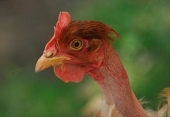Chickens have a lot to offer the vegetable garden, namely pest control, light fertilization, and, if you can direct it, light tillage. Chickens will eat every cricket, grasshopper, pill bug, wire worm, earwig, beetle grub (and adult), cutworm (and moth), squash bug, small snail, and slug they can find in your garden. On the flip side, they will also eat every spider, preying mantis, lizard, and small garter snake they encounter. They have made it possible for me to start growing summer squash again. Prior to this, I had just about given up on growing summer squash since they would produce anywhere from 0 to 3 fruit before the squash borers did them in, but with the chickens around they last all or most of the summer. Instead of the 100's of squash bugs I used to see under the winter squash by summer's end, I rarely see one.
But chickens can be a two edged sword in the garden. They can also scratch up your seed and seedling beds as well as recent transplants, nibble on your lettuce, cole crop and carrot leaves, trample small plants, eat your recently planted melon and beet seed, and make dust wallows in your beds. So the trick with chickens is to maximize the good and minimize their bad effects on the garden.
I’ve been free ranging chickens in my vegetable garden for over 5 years and to accommodate them while minimizing their potential damage, I’ve had to make a few changes in my gardening practices. Chickens love to scratch in recently turned dirt, such as where you have tilled to plant seeds/transplants or weeded out a bed. When seeding or transplanting, I’ll place dog fence wire (2” by 4” openings) over the bed, either lying flat to allow the seedlings or onion transplants to grow up through it, or curved like a tunnel cloche to allow the plants (cole crop transplants) to grow under the protection. The wire will stay on for the entire season with the plants growing up through it. Since chickens don’t like to walk or linger on the wire, it minimizes trampling and nibbling damage to the plants. I use this method for small, easily trampled plants like onions, carrots, and beets.
I also leave lots of edible weeds growing in and around the garden to give the chickens plenty of other plants to eat besides your veggies. When planting large growing plants that they don’t like to nibble on such as sweet potatoes, squash, beans, peas, ocra, pepper, tomato, or eggplant transplants, I will clear a small 6” diameter space/row to plant each seed or transplant, leaving the rest of the bed covered with weeds to distract the chickens. Then as the seedling/transplant grows, I will gradually clear the weeds away in an increasing area around it, once the plant is big enough not to trampled, the entire bed will be weeded in a normal manner.
Irish potatoes can be planted in a normally tilled and weeded bed. The seed potatoes are deep enough not to be dug up by chicken scratching and by the time a potato shoots break surface, the surface of the tilled bed will be old and weathered enough not to attract the chicken’s attention. Potato shoots are large, sturdy, and rarely suffer trampling damage.
Chickens will eat every berry and tomato they can find, so I will put a temporary fence around the strawberry bed during its bearing season. For tomatoes, plant indeterminate tomatoes, trellised up to get the fruit above chicken height as fast as possible. A temporary fence will go around the plants for a few weeks to protect the low hanging tomato fruit until they are harvested and the remaining fruit is too high for the chickens to reach.
Chicken stocking density is important. You want enough chickens to control pests without enough to destroy your garden. The stocking density will depend on your situation, whether the chickens are strictly confined to your garden or whether the garden is just one of many places they can choose to visit (my situation).
Some chicken breeds are more prone to nibbling veggies than others. I have barred rock, favorelle, austrolorp, golden campine, welsummer, and brahmas. Of these, the brahmas are worst for nibbling veggies. Smaller chicken breeds do less trampling damage. Of those I have, welsummers and austrolorps are the optimal breeds for garden patrol.
Chickens like to make dust wallows in low locations with dry soil. With raised beds they will tend to make most of their wallows in the paths as long as they are dry and have weed free areas for them to start their wallows.
To encourage them to help till my beds, when I have an empty bed with some weeds in it, I can go through it and do some weeding/soil disturbance, throw some
compost down, then the chickens will come through, scratch up the rest of the bed and most of the remaining weeds, mixing the compost in the process, leaving a bed ready to seed with a minimal of additional prep.
At this point, I can't imagine having a vegetable garden without some chickens wandering through or gathering around to help me (looking for uncovered edibles) whenever I start weeding a bed.





